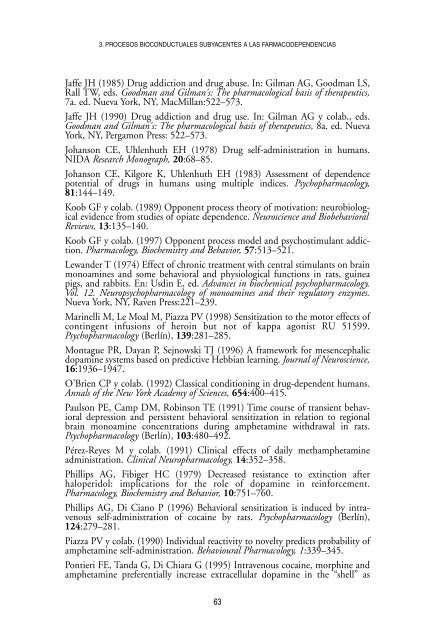Neurociencia del consumo y dependencia de sustancias psicoactivas
Neurociencia del consumo y dependencia de sustancias psicoactivas
Neurociencia del consumo y dependencia de sustancias psicoactivas
Create successful ePaper yourself
Turn your PDF publications into a flip-book with our unique Google optimized e-Paper software.
3. PROCESOS BIOCONDUCTUALES SUBYACENTES A LAS FARMACODEPENDENCIAS<br />
Jaffe JH (1985) Drug addiction and drug abuse. In: Gilman AG, Goodman LS,<br />
Rall TW, eds. Goodman and Gilman's: The pharmacological basis of therapeutics,<br />
7a. ed. Nueva York, NY, MacMillan:522–573.<br />
Jaffe JH (1990) Drug addiction and drug use. In: Gilman AG y colab., eds.<br />
Goodman and Gilman's: The pharmacological basis of therapeutics, 8a. ed. Nueva<br />
York, NY, Pergamon Press: 522–573.<br />
Johanson CE, Uhlenhuth EH (1978) Drug self-administration in humans.<br />
NIDA Research Monograph, 20:68–85.<br />
Johanson CE, Kilgore K, Uhlenhuth EH (1983) Assessment of <strong>de</strong>pen<strong>de</strong>nce<br />
potential of drugs in humans using multiple indices. Psychopharmacology,<br />
81:144–149.<br />
Koob GF y colab. (1989) Opponent process theory of motivation: neurobiological<br />
evi<strong>de</strong>nce from studies of opiate <strong>de</strong>pen<strong>de</strong>nce. Neuroscience and Biobehavioral<br />
Reviews, 13:135–140.<br />
Koob GF y colab. (1997) Opponent process mo<strong><strong>de</strong>l</strong> and psychostimulant addiction.<br />
Pharmacology, Biochemistry and Behavior, 57:513–521.<br />
Lewan<strong>de</strong>r T (1974) Effect of chronic treatment with central stimulants on brain<br />
monoamines and some behavioral and physiological functions in rats, guinea<br />
pigs, and rabbits. En: Usdin E, ed. Advances in biochemical psychopharmacology.<br />
Vol. 12. Neuropsychopharmacology of monoamines and their regulatory enzymes.<br />
Nueva York, NY, Raven Press:221–239.<br />
Marinelli M, Le Moal M, Piazza PV (1998) Sensitization to the motor effects of<br />
contingent infusions of heroin but not of kappa agonist RU 51599.<br />
Psychopharmacology (Berlín), 139:281–285.<br />
Montague PR, Dayan P, Sejnowski TJ (1996) A framework for mesencephalic<br />
dopamine systems based on predictive Hebbian learning. Journal of Neuroscience,<br />
16:1936–1947.<br />
O’Brien CP y colab. (1992) Classical conditioning in drug-<strong>de</strong>pen<strong>de</strong>nt humans.<br />
Annals of the New York Aca<strong>de</strong>my of Sciences, 654:400–415.<br />
Paulson PE, Camp DM, Robinson TE (1991) Time course of transient behavioral<br />
<strong>de</strong>pression and persistent behavioral sensitization in relation to regional<br />
brain monoamine concentrations during amphetamine withdrawal in rats.<br />
Psychopharmacology (Berlín), 103:480–492.<br />
Pérez-Reyes M y colab. (1991) Clinical effects of daily methamphetamine<br />
administration. Clinical Neuropharmacology, 14:352–358.<br />
Phillips AG, Fibiger HC (1979) Decreased resistance to extinction after<br />
haloperidol: implications for the role of dopamine in reinforcement.<br />
Pharmacology, Biochemistry and Behavior, 10:751–760.<br />
Phillips AG, Di Ciano P (1996) Behavioral sensitization is induced by intravenous<br />
self-administration of cocaine by rats. Psychopharmacology (Berlín),<br />
124:279–281.<br />
Piazza PV y colab. (1990) Individual reactivity to novelty predicts probability of<br />
amphetamine self-administration. Behavioural Pharmacology, 1:339–345.<br />
Pontieri FE, Tanda G, Di Chiara G (1995) Intravenous cocaine, morphine and<br />
amphetamine preferentially increase extracellular dopamine in the “shell” as<br />
63

















